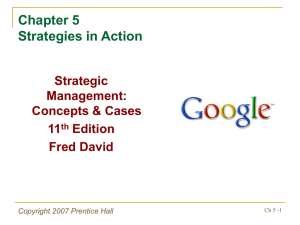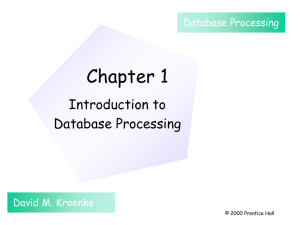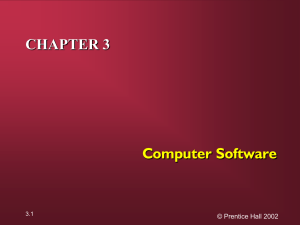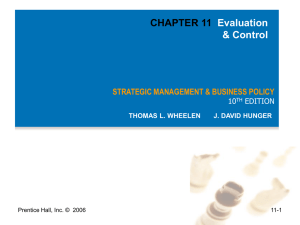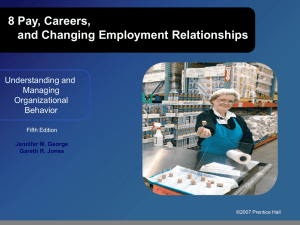Chapter 3 Market Segmentation
advertisement
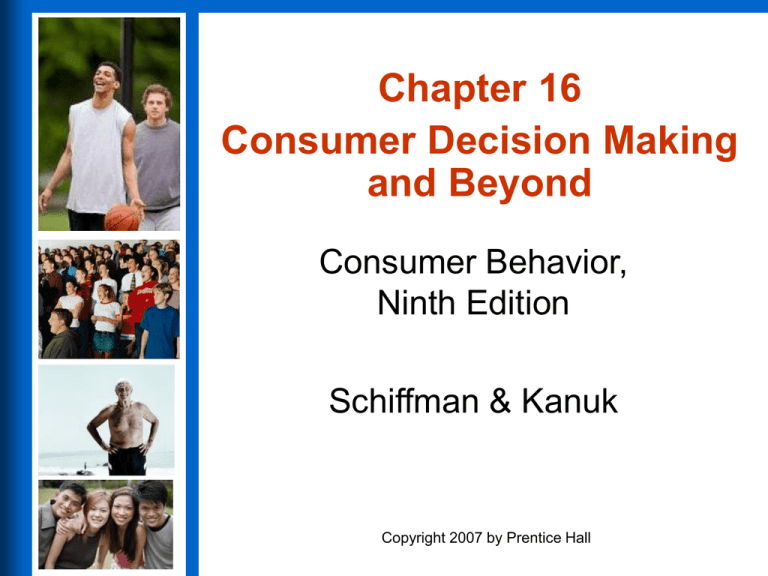
Chapter 16 Consumer Decision Making and Beyond Consumer Behavior, Ninth Edition Schiffman & Kanuk Copyright 2007 by Prentice Hall Chapter Outline • Levels of Consumer Decision Making • Models of Consumer Decision Making • Consumer Gifting Behavior • Relationship Marketing Copyright 2007 by Prentice Hall 16 - 2 Levels of Consumer Decision Making • Extensive Problem Solving – A lot of information needed – Must establish a set of criteria for evaluation • Limited Problem Solving – Criteria for evaluation established – Fine tuning with additional information • Routinized Response Behavior – Usually review what they already know Copyright 2007 by Prentice Hall 16 - 3 Ads often appeal to consumers who are looking for information to help them evaluate products. Copyright 2007 by Prentice Hall 16 - 5 Models of Consumers: Four Views of Consumer Decision Making • • • • An Economic View A Passive View A Cognitive View An Emotional View Copyright 2007 by Prentice Hall 16 - 6 A Simple Model of Consumer Decision Making Figure 16-2 Copyright 2007 by Prentice Hall 16 - 9 The Process of Consumer Decision Making • Need Recognition • Prepurchase Search • Evaluation of Alternatives Copyright 2007 by Prentice Hall 16 - 11 Need Recognition • Usually occurs when consumer has a “problem” • Need recognition styles – Actual state – Desired state Copyright 2007 by Prentice Hall 16 - 12 Prepurchase Search • Begins with internal search and then moves to external search • The impact of the Internet • Search may be personal or impersonal Copyright 2007 by Prentice Hall 16 - 13 Issues in Alternative Evaluation • Evoked set • Criteria used for evaluating brands • Consumer decision rules and their application • Decisions by functionally illiterate population • Going online for decision-making assistance • Lifestyles as a consumer decision strategy • Incomplete information • Series of decisions • Decision rules and marketing strategy Copyright 2007 by Prentice Hall 16 - 14 The Evoked Set Figure 16-3 Copyright 2007 by Prentice Hall 16 - 15 Issues in Alternative Evaluation • Evoked Set • Criteria used for evaluating brands • Consumer decision rules and their application • Decisions by functionally illiterate population • Going online for decision-making assistance • Lifestyles as a consumer decision strategy • Incomplete information • Series of decisions • Decision rules and marketing strategy Copyright 2007 by Prentice Hall 16 - 16 Consumer Decision Rules • Compensatory • Noncompensatory – Conjunctive Decision Rule – Disjunctive Decision Rule – Lexicographic Rule Copyright 2007 by Prentice Hall 16 - 17 Compensatory Decision Rules Copyright 2007 by Prentice Hall A type of decision rule in which a consumer evaluates each brand in terms of each relevant attribute and then selects the brand with the highest weighted score. 16 - 18 Noncompensatory Decision Rules Copyright 2007 by Prentice Hall A type of consumer decision rule by which positive evaluation of a brand attribute does not compensate for a negative evaluation of the same brand on some other attribute. 16 - 19 Conjunctive Decision Rule Copyright 2007 by Prentice Hall A noncompensatory decision rule in which consumers establish a minimally acceptable cutoff point for each attribute evaluated. Brands that fall below the cutoff point on any one attribute are eliminated from further consideration. 16 - 20 Disjunctive Rule Copyright 2007 by Prentice Hall A noncompensatory decision rule in which consumers establish a minimally acceptable cutoff point for each relevant product attribute. 16 - 21 Lexicographic Rule Copyright 2007 by Prentice Hall A noncompensatory decision rule consumers first rank product attributes in terms of importance, then compare brands in terms of the attribute considered most important. 16 - 22 Affect Referral Decision Rule Copyright 2007 by Prentice Hall A simplified decision rule by which consumers make a product choice on the basis of their previously established overall ratings of the brands considered, rather than on specific attributes. 16 - 23 Issues in Alternative Evaluation • Evoked Set • Criteria used for evaluating brands • Consumer decision rules and their application • Decisions by functionally illiterate population • Going online for decision-making assistance • Lifestyles as a consumer decision strategy • Incomplete information • Series of decisions • Decision rules and marketing strategy Copyright 2007 by Prentice Hall 16 - 24 The Decision Process for Functionally Illiterate Consumers Figure 16-4 Copyright 2007 by Prentice Hall 16 - 25 Issues in Alternative Evaluation • Evoked Set • Criteria used for evaluating brands • Consumer decision rules and their application • Decisions by functionally illiterate population • Going online for decision-making assistance • Lifestyles as a consumer decision strategy • Incomplete information • Series of decisions • Decision rules and marketing strategy Copyright 2007 by Prentice Hall 16 - 28 Coping with Missing Information • Delay decision until missing information is obtained • Ignore missing information and use available information • Change the decision strategy to one that better accommodates for the missing information • Infer the missing information Copyright 2007 by Prentice Hall 16 - 29 Output of Consumer Decision Making • Purchase behavior • Postpurchase evaluation Copyright 2007 by Prentice Hall 16 - 32 Purchase Behavior • Three types of behavior – Trial purchases – Repeat purchases – Long-term commitment Copyright 2007 by Prentice Hall 16 - 33 Postpurchase Evaluation • Actual Performance Matches Expectations – Neutral Feeling • Actual Performance Exceeds Expectations – Positive Disconfirmation of Expectations • Performance Is Below Expectations – Negative Disconfirmation of Expectations Copyright 2007 by Prentice Hall 16 - 34 Gifting Behavior Gifting is an act of symbolic communication, with explicit and implicit meanings ranging from congratulations and love, to regret, obligation, and dominance. Copyright 2007 by Prentice Hall 16 - 37 Table 16.13 Reported Circumstances and Motivations for Self-Gift Behavior CIRCUMSTANCES MOTIVATIONS Personal accomplishment Feeling down Holiday Feeling stressed Have some extra money Need Had not bought for self in a while Attainment of a desired goal Others To reward oneself To be nice to oneself To cheer up oneself To fulfill a need To celebrate To relieve stress To maintain a good feeling To provide an incentive toward a goal Others Copyright 2007 by Prentice Hall 16 - 39 Relationship Marketing Copyright 2007 by Prentice Hall Marketing aimed at creating strong, lasting relationships with a core group of customers by making them feel good about the company and by giving them some kind of personal connection with the business. 16 - 42 Proctor & Gamble Builds Relationships with Their Brands Proctor & Gamble Copyright 2007 by Prentice Hall 16 - 43 State Farm Insurance stresses relationship marketing in their advertising. Copyright 2007 by Prentice Hall 16 - 44
